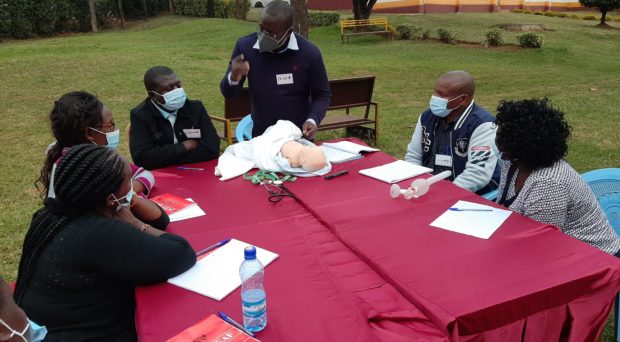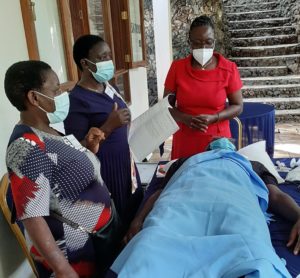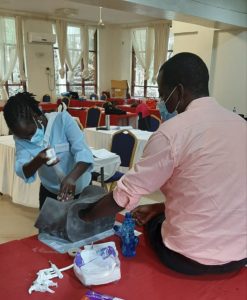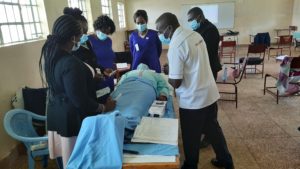
The critical role of midwives in improving maternal and newborn health
The risk of death during pregnancy and childbirth is greatest in resource-limited settings, and ending preventable maternal mortality requires critical investments in frontline maternity care providers to meet the ambitious Sustainable Development Goal (SDG) maternal and newborn health (MNH) targets by 2030.
Midwives educated and regulated to international standards and working in well-equipped enabling environments provide 87% of essential MNH care services. It is estimated that universal coverage of essential maternal, newborn and family planning interventions that fall within the scope of midwifery practice could prevent 83% of all maternal and newborn deaths and stillbirths. Scaling up the provision of midwife-led care globally could translate to saving 4.3 million maternal and newborn lives per year by 2035.
During the COVID-19 pandemic, midwives have remained at the frontline saving the lives of women and their newborns despite challenges with personal protective equipment, work-related stress and ineffective communications. Therefore, greater investment in midwifery is an essential pathway to achieving SDG 3 MNH targets.
Challenges to midwifery training and education
Countries are making efforts to expand and deliver equitable midwifery services, but comprehensive, disaggregated data for determining the availability, accessibility, acceptability and quality of the midwifery workforce are not available.

Evidence shows a wide gap between current evidence-based standards and provider competence to manage selected obstetric and neonatal complications. Also, there is evidence of significant variation in the knowledge and skills of maternity care providers by country in sub-Saharan Africa. Besides, pre-service midwifery education curricula have been criticized as being largely didactic and deficient in low- and middle-income countries (LMICs).
Countries must invest in midwifery education to meet the current standards for skilled health personnel (SHP). SHP are competent MNH professionals educated, trained and regulated to national and international standards (International Confederation of Midwives) and competent to identify and manage or refer women and/or newborns with complications, and thus can perform all signal functions of emergency maternal and newborn care (EmOC) to optimize the health and wellbeing of women and newborns.
To improve the competence of midwives, midwifery education programs should be strengthened to meet international standards. What is the best way to improve the training and education of SHP? What are the most efficient ways of doing this? What is the impact of SHP interventions? For these interventions to be effective they have to be context-specific.
A structured approach to improving in-service midwifery training and education programs in Kenya
Partnerships for improved midwifery education
Improving the quality of midwifery education in Kenya has been achieved through effective partnerships. Support for implementation research through the UK Foreign and Commonwealth Development Office Kenya and the Johnson and Johnson Centre for Health Worker Innovation.

Collaboration with the Nursing Council of Kenya, Clinical Officers Council of Kenya, and pre-service training taskforce chaired by the Kenya Ministry of Health (MoH), ensured that a comprehensive review of the syllabi and curriculum for midwives and clinical officers in Kenya was undertaken.
The Emergency Obstetric Care and Quality of Care unit, International Public Health Department at the Liverpool School of Tropical Medicine (LSTM) has developed and managed these partnerships aimed at improving the competencies of SHP. This is essential for improved quality of maternal and newborn care for the achievement of SDG 3 targets through a health system approach in Kenya.
Midwifery education: training syllabus and curriculum
The Kenya MoH established the national pre-service taskforce mandated to coordinate the integration of EmOC at pre-service level training for SHP. LSTM supported the Nursing Council of Kenya in 2019 to review and update the midwifery training syllabi to reflect the current international SHP competencies integrating the EmOC.
Consequently, the midwifery curriculum at the Kenya Medical Training College, the biggest single contributor of human resources for health in Kenya, accounting for more than 85% of the hospital workforce, was revised and updated.
Evaluation of the effectiveness of midwifery education interventions
A cluster randomized controlled trial in Kenya investigated the effectiveness of an EmOC-improved curriculum, capacity strengthening of midwifery educators, provision of hands-on training equipment and mentoring of trained midwifery educators. The trial showed a statistically significant improvement in the skills of final-year midwifery students in the intervention group compared to the control group. That study was the proof of concept that led to updating of the national midwifery education syllabi in Kenya.

With the curriculum now formally updated with the participation of all partners, a comprehensive study to measure its effectiveness is being undertaken in Kenya. In addition to the capacity strengthening of midwifery and clinical medicine educators, mentoring will be provided to educators and equipment for skills training will be provided. It is expected the experience from Kenya and the results from this trial will serve as a template for investments in midwifery education in other LMICs.
Comments